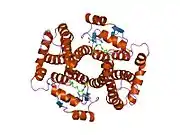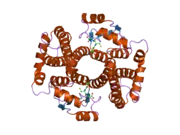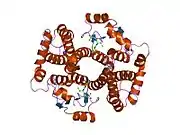GSTA3
Glutathione S-transferase A3 is an enzyme that in humans is encoded by the GSTA3 gene.[5][6][7]
| GSTA3 | |||||||||||||||||||||||||||||||||||||||||||||||||||
|---|---|---|---|---|---|---|---|---|---|---|---|---|---|---|---|---|---|---|---|---|---|---|---|---|---|---|---|---|---|---|---|---|---|---|---|---|---|---|---|---|---|---|---|---|---|---|---|---|---|---|---|
 | |||||||||||||||||||||||||||||||||||||||||||||||||||
| |||||||||||||||||||||||||||||||||||||||||||||||||||
| Identifiers | |||||||||||||||||||||||||||||||||||||||||||||||||||
| Aliases | GSTA3, GSTA3-3, GTA3, glutathione S-transferase alpha 3 | ||||||||||||||||||||||||||||||||||||||||||||||||||
| External IDs | OMIM: 605449 MGI: 95856 HomoloGene: 37355 GeneCards: GSTA3 | ||||||||||||||||||||||||||||||||||||||||||||||||||
| |||||||||||||||||||||||||||||||||||||||||||||||||||
| |||||||||||||||||||||||||||||||||||||||||||||||||||
| |||||||||||||||||||||||||||||||||||||||||||||||||||
| |||||||||||||||||||||||||||||||||||||||||||||||||||
| |||||||||||||||||||||||||||||||||||||||||||||||||||
| Wikidata | |||||||||||||||||||||||||||||||||||||||||||||||||||
| |||||||||||||||||||||||||||||||||||||||||||||||||||
Cytosolic and membrane-bound forms of glutathione S-transferase are encoded by two distinct supergene families. These enzymes are involved in cellular defense against toxic, carcinogenic, and pharmacologically active electrophilic compounds. At present, eight distinct classes of the soluble cytoplasmic mammalian glutathione S-transferases have been identified: alpha, kappa, mu, omega, pi, sigma, theta and zeta. This gene encodes a glutathione S-transferase belonging to the alpha class genes that are located in a cluster mapped to chromosome 6. Genes of the alpha class are highly related and encode enzymes with glutathione peroxidase activity. However, during evolution, this alpha class gene diverged accumulating mutations in the active site that resulted in differences in substrate specificity and catalytic activity. The enzyme encoded by this gene catalyzes the double bond isomerization of precursors for progesterone and testosterone during the biosynthesis of steroid hormones. An additional transcript variant has been identified, but its full length sequence has not been determined.[7]
References
- GRCh38: Ensembl release 89: ENSG00000174156 - Ensembl, May 2017
- GRCm38: Ensembl release 89: ENSMUSG00000025934 - Ensembl, May 2017
- "Human PubMed Reference:". National Center for Biotechnology Information, U.S. National Library of Medicine.
- "Mouse PubMed Reference:". National Center for Biotechnology Information, U.S. National Library of Medicine.
- Suzuki T, Johnston PN, Board PG (Mar 1994). "Structure and organization of the human alpha class glutathione S-transferase genes and related pseudogenes". Genomics. 18 (3): 680–6. doi:10.1016/S0888-7543(05)80373-8. PMID 8307579.
- Board PG (Apr 1998). "Identification of cDNAs encoding two human alpha class glutathione transferases (GSTA3 and GSTA4) and the heterologous expression of GSTA4-4". Biochem J. 330 (2): 827–31. doi:10.1042/bj3300827. PMC 1219212. PMID 9480897.
- "Entrez Gene: GSTA3 glutathione S-transferase A3".
Further reading
- Johansson AS, Mannervik B (2001). "Human glutathione transferase A3-3, a highly efficient catalyst of double-bond isomerization in the biosynthetic pathway of steroid hormones". J. Biol. Chem. 276 (35): 33061–5. doi:10.1074/jbc.M104539200. PMID 11418619.
- Johansson AS, Mannervik B (2002). "Active-site residues governing high steroid isomerase activity in human glutathione transferase A3-3". J. Biol. Chem. 277 (19): 16648–54. doi:10.1074/jbc.M201062200. PMID 11872752.
- Strausberg RL, Feingold EA, Grouse LH, et al. (2003). "Generation and initial analysis of more than 15,000 full-length human and mouse cDNA sequences". Proc. Natl. Acad. Sci. U.S.A. 99 (26): 16899–903. Bibcode:2002PNAS...9916899M. doi:10.1073/pnas.242603899. PMC 139241. PMID 12477932.
- Mungall AJ, Palmer SA, Sims SK, et al. (2003). "The DNA sequence and analysis of human chromosome 6". Nature. 425 (6960): 805–11. Bibcode:2003Natur.425..805M. doi:10.1038/nature02055. PMID 14574404.
- Tetlow N, Coggan M, Casarotto MG, Board PG (2005). "Functional polymorphism of human glutathione transferase A3: effects on xenobiotic metabolism and steroid biosynthesis". Pharmacogenetics. 14 (10): 657–63. doi:10.1097/00008571-200410000-00003. PMID 15454730.
- Gerhard DS, Wagner L, Feingold EA, et al. (2004). "The status, quality, and expansion of the NIH full-length cDNA project: the Mammalian Gene Collection (MGC)". Genome Res. 14 (10B): 2121–7. doi:10.1101/gr.2596504. PMC 528928. PMID 15489334.
- Gu Y, Guo J, Pal A, et al. (2005). "Crystal structure of human glutathione S-transferase A3-3 and mechanistic implications for its high steroid isomerase activity". Biochemistry. 43 (50): 15673–9. doi:10.1021/bi048757g. PMID 15595823.
- Suzuki T, Delgado-Escueta AV, Alonso ME, et al. (2006). "Mutation analyses of genes on 6p12-p11 in patients with juvenile myoclonic epilepsy". Neurosci. Lett. 405 (1–2): 126–31. doi:10.1016/j.neulet.2006.06.038. PMID 16876319. S2CID 20526126.



















